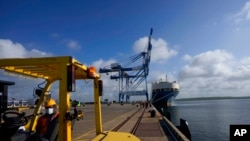As Beijing marks the 10-year anniversary of its Belt and Road Initiative or BRI, China’s state media is lauding the program’s efforts to boost connectivity and build out global infrastructure.
More than 150 countries and 32 international organizations have joined the massive global transportation and infrastructure project with more than 200 agreements currently underway or completed, according to the Belt and Road Portal, China’s official website that promotes the BRI.
What started as an effort to rebuild old Silk Road trade routes through Central Asia is now reaching every continent and the North and South Pole regions.
But despite Beijing’s success in building infrastructure, roads and railways to improve connectivity, observers say President Xi Jinping’s flagship initiative is becoming increasingly controversial and unpopular among some host countries.
A 2021 study conducted by the U.S.-based research lab AidData found 35% of BRI infrastructure projects have been plagued by controversies such as corruption, excessive debt and labor exploitation.
With projects estimated at more than $1 trillion, BRI has fallen short of its five goals: policy coordination, capital allocation, infrastructure connectivity, trade facilitation and people-to-people bonds, some analysts say.
"By design, connectivity is meaningless without real shared norms and values of global governance," said Niva Yau, a Japan-based nonresident fellow with the Atlantic Council’s Global China Hub.
Massive corruption
Failed projects include the dry port of Khorgos in Kazakhstan, the Hambantota port in Sri Lanka and a soon-to-be-launched east coast rail link in Malaysia, said Yau.
Their levels of failure are different, but all have one commonality — corruption, Yau told VOA Mandarin in a recent interview.
“All of these projects illustrate the weakness of BRI, being the massive corruption, and that stems from China's approach to work only with local elites,” said Yau.
She said elites in Kazakhstan have skimmed off millions of dollars through hidden customs tariffs on Chinese imports across the Khorgos border. The Hambantota port curried favor with Sri Lankan elites supported by China, while the China-funded rail project in Malaysia was once halted during a corruption scandal involving former Prime Minister Najib Razak.
Yau said China did nothing to address the failures of governance and policy coordination that allowed the elites of BRI client states to siphon off money loaned by Beijing while the countries’ taxpayers were left with the debts.
Chinese debt
Some Western critics have warned about the BRI’s capital allocation model with loan interest rates of up to 7 to 10%. Countries that cannot pay off the loans are then put at risk of yielding control of infrastructure such as ports to China.
However, the idea of a “debt trap” has been dismissed by some economists and political scientists. Ammar Malik, a senior research scientist at AidData, a research lab at William & Mary, a university in Virginia, credited the Chinese for meeting infrastructure gaps which BRI recipient countries voluntarily identified.
Studies show that in the first few years after their completion, BRI projects tend to have positive economic effects, Malik told VOA Mandarin.
"It is not a surprising finding. In my view, because if you pump in a whole lot of infrastructure into an economy, which didn't have it, and if there were two places which did not trade with each other because they were not connected, and suddenly you put a bridge, of course, the economic activity will increase," said Malik.
But many BRI borrowers are now at a stage of repaying their loans after having run into financial difficulty, which was exacerbated by the pandemic, he said. This is especially true for countries like Zambia, which overdid BRI projects.
Some loans from China are repeatedly extended, with interest rates averaging 5%. In contrast, the interest rate of an organization such as the International Monetary Fund is around 2%, AidData’s research found.
Chinese lending declines
The Boston University Global Development Policy Center has a database that shows that Chinese lending in Africa dropped to a new low of $994.5 million in 2022 from its 2016 peak of $28.5 billion. The decrease may be due to China's debt burden concerns, according to a September report issued by the center’s Global China Initiative.
China’s approach of “cooperation instead of development” puts the responsibility for BRI projects on recipient countries, which may lack environmental, social or safety standards to do proper risk assessments before a project begins, Malik said.
“The Chinese do not have a developmental orientation in the way that a World Bank or an IFC [International Finance Corporation] works. They have a more commercial orientation. They work as bankers who are interested in delivering projects on time and making sure that the returns come on time. And they don't bring their own standards,” said Malik.
Beijing insists that its BRI scheme has achieved “massive advances.”
Statistics developed by China’s National Development and Reform Commission show that the co-development agreements China has signed with countries and international organizations have boosted the import and export of goods between China and recipient countries by an average of 8.6% annually with cumulative two-way investment exceeding $270 billion in the past decade.
One-way trade?
The commission also heralded the BRI’s success in infrastructure connectivity after landmark projects such as the China-Europe Railway Express and the New International Land-Sea Trade Corridor connected China to 300 ports in more than 100 countries.
But such connectivity, the Atlantic Council’s Yau noted, also serves to facilitate an even more efficient dumping of Chinese goods in other markets — one of the reasons behind Italy’s expected decision to quit the BRI.
Beijing does not feel obliged to reverse the market condition, where it benefits Chinese exports said Malik.
One of the BRI’s goals is people-to-people relationships. However, it has backfired, as workers in recipient countries have complained about China sending up to a million of its own workers overseas to work on BRI projects instead of hiring employees locally, said Li Qiang, executive director of China Labor Watch in New York.
He added that Chinese workers, who took up these BRI jobs overseas, complained about exploitation, mistreatment, and more recently unpaid wages as the Chinese economy slows.
“Following delays in construction payments, [suppliers and contractors] have delayed wages to [Chinese] workers for as long as three to four months. Sometimes, wages were paid after [the] workers have returned to China,” Li told VOA Mandarin.
BRI 2.0 with a sustainable vision?
Defending the BRI plan, Xin Wang, president of Charigo Center for International Economic Cooperation in Beijing, told VOA Mandarin that the project has succeeded in expanding China’s circle of friends and overseas trade ties while boosting infrastructure building and economic activities in developing countries.
China’s planned BRI 2.0 will have with an emphasis on green and high-tech development, he added.
AidData’s Malik also expects Beijing to uphold environmental, social and governance standards in its next iteration of the BRI to ensure its assets in Belt and Road projects won’t turn into liabilities.












